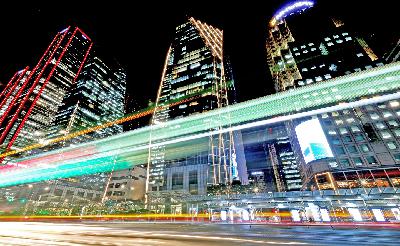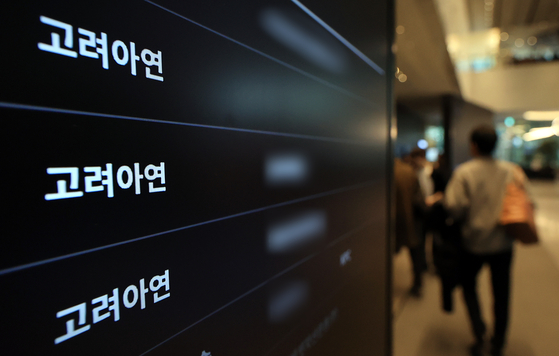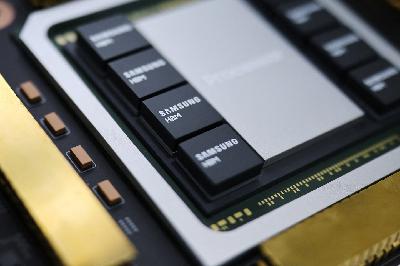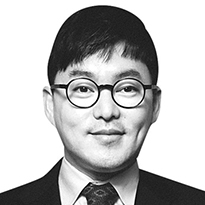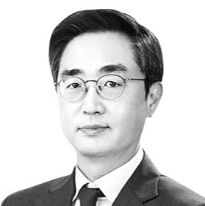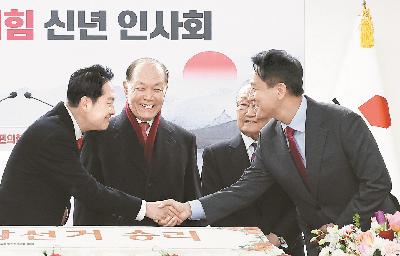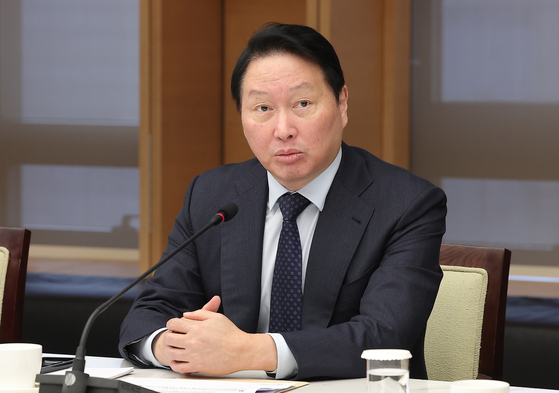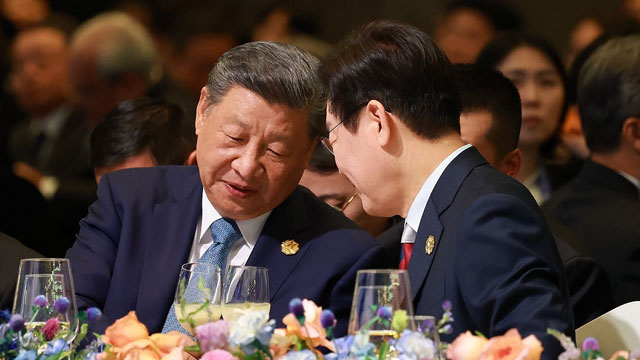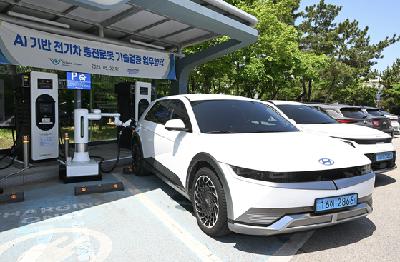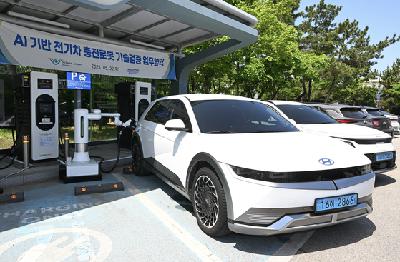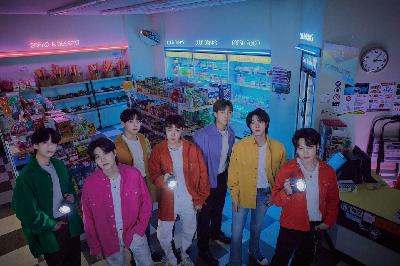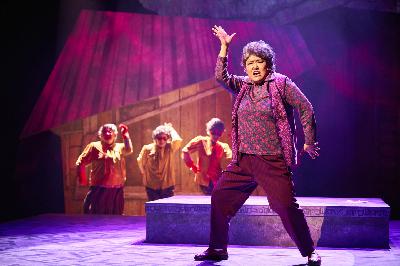Discover Korea JoongAng Daily - Daily News from Korea
Korea JoongAng Daily - Daily News from Korea

Korea JoongAng Daily - Daily News from Korea
Author: Newsroom of the Korea JoongAng Daily
Subscribed: 45Played: 7,860Subscribe
Share
© JoongAng Daily Co., Ltd.
Description
Audio recordings of the Korea JoongAng Daily's in-depth, on-the-scene news articles and features informing readers around the world of the issues of the day in Korea.
Under the slogan "Your window to Korea", the Korea JoongAng Daily is an English-language news organization focused on Korea that strives to publish factual, timely and unbiased articles.
Under the slogan "Your window to Korea", the Korea JoongAng Daily is an English-language news organization focused on Korea that strives to publish factual, timely and unbiased articles.
4979 Episodes
Reverse
This article is by Jang Seo-yun and read by an artificial voice.
Korea's benchmark Kospi crossed 4,000 for the first time in 2025, lifted by semiconductor stocks and other large-cap technology shares. Investors now want to know if it can break through 5,000 this year, amid AI bubble concerns and the risk of foreign outflows driven by currency swings.
That question has split market strategists. Research chiefs at five major securities firms - Mirae Asset Securities, Hana Securities, Korea Investment & Securities, KB Securities and NH Investment & Securities - expect the index to range anywhere from as low as 3,750 to as high as 5,500 this year. Excluding Mirae Asset, which did not present a specific target, the group is evenly divided on whether the long-discussed 5,000 level is within reach.
Expectations for a bullish Kospi has mounted entering 2026, as the main bourse broke past the 4,300 level on Jan. 2, the first trading day of the year. It closed at 4,309.63 on Friday, up 2.27 percent from the previous trading on Dec. 30 of last year.
Bulls see policy support and chip earnings
NH Investment & Securities offered the most optimistic forecast, projecting a range of 4,000 to 5,500. Cho Soo-hong, head of research, said the index could reach the upper end of that range as early as the third quarter.
"Growth led by semiconductors is continuing, and a market re-rating driven by policies aimed at normalizing the capital market should also persist," Cho said.
He pointed to sharply rising earnings expectations for Samsung Electronics and SK hynix, the two largest companies on the Kospi by market capitalization.
"Combined operating profit forecasts for the two companies have been revised up from about 160 trillion won [$110.8 billion] to more than 200 trillion won this year," he said.
KB Securities also said the Kospi could test the 5,000 level. Kim Dong-won, its head of research, framed the outlook around the durability of AI demand.
"The growth cycle of the AI industry that underpins demand for Korean semiconductors could last as long as 10 years," Kim said. "There will be fluctuations, but the base level of AI growth itself is rising."
He added that earnings from the so-called Magnificent Seven - Microsoft, Meta, Amazon, Alphabet, Apple, Nvidia and Tesla - continue to outperform the broader S&P 500, reinforcing confidence in technology-led markets.
Kim Hak-kyun, head of research at ShinYoung Securities, struck a similar tone in a report published on Tuesday, written in the form of a self-critique titled "My mistakes in 2025" (translated).
"I could not even imagine the Kospi reaching 4,000 amid the strange combination of a weak won and rising stock prices," Kim wrote. "Now, reaching 5,000 or even 6,000 no longer seems impossible."
Kim argued that if the United States turns to exchange rates rather than tariffs to address external imbalances, the dollar's strength could give way to a more structural decline.
"If the won strengthens [as the dollar weakens], Korean stocks could gain appeal as non-dollar assets," he said.
Caution focuses on the second half
More conservative forecasts came from Hana Securities, which projected a range of 3,750 to 4,650, and Korea Investment & Securities, which put its upper bound at 4,600. Both firms expect gains to be front-loaded, with conditions becoming more challenging in the second half of the year.
They cited the risk of prolonged weakness in the won and tighter monetary conditions, which could weigh on foreign investor demand.
Yoo Jong-woo, head of research at Korea Investment & Securities, said the exchange rate would be the decisive factor if the index fails to reach 5,000.
"If the Kospi does not reach 5,000, the main reason will be the currency," Yoo said. "In the second half, a weaker won would limit monetary easing and worsen the supply-and-demand environment."
Hwang Seung-taek, head of research at Hana Securities, warned that inflation pressures could erode expectations for interest r...
This article is by Sarah Chea and read by an artificial voice.
Samsung SDI CEO Choi Joo-sun underscored the importance of technology and described the year as a turning point for renewed growth in his New Year's message for 2026, even as battery makers face an exceptionally challenging period amid a slowdown in EV demand.
"There is nowhere to step back anymore. We must move forward now," Choi said in the message for all employees on Friday. "Ultimately, the answer lies in our essence - technology. To that end, we must move forward as one through alignment."
Choi presented his "3S" philosophy as a guiding principle for Samsung SDI's strategic direction for the new year. "Select" emphasizes focus and prioritization, "Speed" means faster responses to customers and the market and "Survival" highlights dedication to ensuring the company's continued competitiveness.
Citing what he called "pessimistic optimism," the CEO said, "Despite the complex situations we're facing, if we secure technological competitiveness and move toward a supercycle in a united direction, I believe we will soon welcome the breathtaking future."
According to Choi, pessimistic optimism refers to an attitude that acknowledges real-world risks and limitations, prepares thoroughly for the worst, but expects positive outcomes.
"Each and every day presented a new challenge, and uncertainty remained as a constant presence," Choi added. "If we continue to hold the belief that technology is hope and communicate with open hearts, the breathtaking future we envision will soon become our reality."
"I hope that our journey this year marks the starting point of our new leap forward," the CEO said as he concluded the message.
This article is by Sarah Chea and read by an artificial voice.
A Seoul court has ordered Young Poong and MBK Partners to disclose contractual documents they executed during their attempt to acquire management control of Korea Zinc, a step aimed at verifying whether the two parties engaged in an unfair transaction involving the discounted sale of Korea Zinc shares.
The Seoul Central District Court recently granted a document submission request filed by KZ Precision, a subsidiary of Korea Zinc, against Young Poong. The ruling requires advisory figures, including Young Poong's former CEO Jang Hyung-jin, to submit the original shareholder agreement with MBK and subsequent amendments.
The key to the ruling is whether the agreement facilitated Young Poong's guarantee that MBK Partners could acquire a portion of Korea Zinc shares at a specific, preferential price.
MBK Partners in September entered into a shareholders' agreement with Young Poong aides, agreeing to jointly exercise voting rights. As part of the deal, it was granted call options on certain shares owned by Young Poong and its affiliates.
However, the exercise price wasn't disclosed in public filings, sparking speculation that Young Poong may have fixed the price or linked it to MBK's public tender offer price.
Korea Zinc has filed a shareholder derivative lawsuit against Young Poong, arguing that such a call option constitutes a breach of fiduciary duty to Young Poong's shareholders.
For Young Poong, the Korea Zinc shares represent a critical asset in terms of cash flow, as the company has been receiving roughly 100 billion won ($62.3 million) annually in dividends from Korea Zinc. The dividends have served as a vital source of funding for Young Poong operations, especially during the past three consecutive years of massive losses, which has raised criticism that the deal could amount to a breach of fiduciary responsibility.
If the court decides that contractual documents verify the veracity of Korea Zinc's claims, it is widely anticipated that the lawsuit would tilt in favor of Korea Zinc.
"The market and shareholders must have a clear resolution regarding the price and terms under which Korea Zinc shares, Young Poong's most valuable asset, was transferred to MBK Partners," KZ Precision said in a statement.
"If the allegations raised in the media are substantiated, key decision-makers and executives, including Jang, are likely to face significant liability in the shareholder derivative suit and potential damages claims."
Meanwhile, Korea Zinc said Friday it has completed payment for a third-party share issuance allocated to the Crucible joint venture, in which the U.S. government participates as a major stakeholder. Korea Zinc's board on Dec. 15, 2025, approved a $7.4 billion investment to build a smelting facility in Clarksville, Tennessee.
The transaction effectively opens the door for the United States to indirectly acquire an estimated 10 percent stake in Korea Zinc, a development that gives Chairman Choi Yoon-bum somewhat of an upper hand in his ongoing battle for management control against the Young Poong-MBK alliance.
The stake held by shareholders aligned with Choi is expected to rise to around 40 percent. Considering the interest of Korea's National Pension Service, which holds a 4.8 percent stake and is widely viewed as a potential swing voter, Choi's side may surpass the 42.1 percent held by Young Poong and MBK.
"With the listing date for the newly issued shares set for January 9, we plan to begin site development in 2026 and commence phased commercial production starting in 2029," Korea Zinc said.
"The facility will produce 13 categories of materials, including industrial base metals such as zinc, lead and copper, as well as antimony, indium and bismuth, and of them, 11 are included on the U.S. government's 2025 Critical Minerals List," it added. "Our goal is to process 1.1 million tons of raw materials annually and produce 540,000 tons of finished prod...
This article is by Park Young-woo, Lee Su-jeong and read by an artificial voice.
Korea's year-end corporate bonuses in 2025 are diverging sharply, with firms in semiconductors, power equipment and shipbuilding preparing record payouts while companies in petrochemicals and batteries scale back amid prolonged downturns.
Samsung Electronics announced in an internal notice that employees in its semiconductor division can expect to receive bonuses worth up to nearly half of their annual salaries in 2025 under the company's excess profit incentive system, according to business officials on Wednesday.
The Device Solutions division, which oversees the company's semiconductor operations, is expected to receive bonuses equivalent to 43 to 48 percent of individual annual salaries, approaching the highest level since the so-called overall performance incentive system was introduced.
Under the scheme, Samsung pays up to 50 percent of an employee's annual salary when a division meets performance targets, using up to 20 percent of excess profits.
The Mobile Experience division, which includes smartphones, is expected to receive 45 to 50 percent. In contrast, payout rates for the Visual Display, Digital Appliances and Network divisions were set at 9 to 12 percent.
Higher bonuses in the semiconductor unit reflect a rebound in commodity dynamic random access memory prices and rising sales of high bandwidth memory. Samsung will also pay a target achievement incentive for the second half of last year equivalent to up to 100 percent of monthly base pay.
SK hynix is also expected to deliver sharply higher bonuses. Labor and management agreed in September of last year to allocate 10 percent of operating profit to performance-sharing bonuses and to scrap the previous cap of 1,000 percent of base pay. Industry sources expect bonuses paid early next year to average more than 100 million won ($70,000) per employee.
Companies supplying power equipment, which have benefited from the AI investment cycle, are also reporting record payouts.
HD Hyundai Electric said it will pay bonuses equivalent to 1,195 percent of base pay for 2025, exceeding last year's 1,077 percent and marking a record high. The increase reflects strong demand for products such as ultra-high-voltage transformers, driven by the expansion of AI data centers and replacement demand for aging power grids in North America and Europe.
The company typically calculates bonuses at roughly 60 to 70 times its operating margin. With its 2025 operating margin expected to exceed 20 percent, employees will receive bonuses above 1,000 percent for a second consecutive year.
The shipbuilding sector has also seen improved compensation. HD Hyundai Heavy Industries, which launched as an integrated entity on Dec. 1 of last year, will pay nonsalaried employees bonuses exceeding 600 percent of base pay ahead of Korea's "Make American Shipbuilding Great Again" investment initiative in the U.S. shipbuilding sector.
Employees formerly with HD Hyundai Heavy Industries will receive 638 percent of standard wages, while those from HD Hyundai Mipo will receive 559 percent. Production workers will receive bonuses based on organizational and individual performance, with some payments to be settled later.
By contrast, petrochemical and battery makers continue to face weak market conditions, weighing heavily on year-end compensation.
Petrochemical companies are grappling with oversupply from China and slowing global demand, prompting discussions on work force redeployment and restructuring alongside bonus reductions. Some battery makers are also prioritizing cost controls over compensation as slowing EV demand pressures earnings.
"Industries such as AI semiconductors, power infrastructure and shipbuilding are directly tied to global policy and demand, allowing earnings momentum to continue," said Lee Jong-woo, a professor of business administration at Ajou University. "Sectors facing oversupply remain in an adjustment ...
This article is by Kim Ji-ye and read by an artificial voice.
There were no breakout hits like " Squid Game" (2021-25) in 2025, but the year still produced some noticeable successes, such as " The Trauma Code: Heroes Call" (2025), " When Life Gives You Tangerines" (2025) and "Bon Appétit, Your Majesty" (2025).
Looking ahead, 2026 is already shaping up to be a packed year, with some popular series making a comeback, new projects from renowned film directors on the horizon and romance series led by star-studded casts set for release.
The Korea JoongAng Daily has compiled a list of Korean films, TV dramas and streaming platform projects coming out this year that viewers may want to keep an eye on.
For streaming platforms and TVs
'Can This Love Be Translated?'
The upcoming romance series "Can This Love Be Translated?" is set to be the first project to kick off Netflix's 2026 Korean lineup. The series follows an unexpected romance between Ju Ho-jin, a multilingual translator, and Cha Mu-hee, a globally famous actor.
Actor Kim Seon-ho stars as Ho-jin and Go Youn-jung as Mu-hee. The rom-com is written by renowned screenwriters, Hong Jung-eun and Hong Mi-ran - known as the Hong Sisters - who have written numerous hit series, including "Hotel del Luna" (2019). Yoo Young-eun directs the project.
"Can This Love Be Translated?" will start airing on Netflix on Jan. 16.
'No Tail to Tell'
Actor Kim Hye-yoon is set to return as a gumiho, a nine-tailed fox from Korean folklore, in the upcoming SBS series "No Tail to Tell." A gumiho is a mythical creature that can transform into a beautiful woman. It is often depicted to lure men to eat their heart or liver to get the chance to become fully human.
The upcoming series follows Eun-ho, a gumiho who has no desire to become fully human, and Si-yeol, a world-class soccer player, as they meet and their destinies take a turn neither of them expected.
Actor Lomon from "All of Us Are Dead" (2022) is set to play soccer player Si-yeol, alongside Kim portraying Eun-ho. The series will be directed by Kim Jeong-kwon.
The series will also be actor Kim Hye-yoon's first project since the hit rom-com "Lovely Runner" (2024).
"No Tail to Tell" will air on SBS and will be available on Netflix. The first episode will debut on Jan. 16.
'Perfect Crown'
"Lovely Runner" breakout star Byeon Woo-seok is set to return to screens as a prince in an alternate Korea under a constitutional monarchy in the upcoming MBC series "Perfect Crown."
Byeon will star next to singer-actor IU. Actors Noh Sang-hyun and Gong Seung-yeon are also set to join the cast.
Set in a fictional monarchical Korea, the show will center on Seong Hee-ju, an ordinary woman from a wealthy chaebol family, and Lee Wan, the King's second son, whose royal status limits his potential. IU will play Hee-ju, while Byeon takes on the role of Lee Wan.
Directed by Park Joon-hwa, who was behind "Alchemy Souls" (2022-23), MBC's "Perfect Crown" is scheduled to be released in early 2026 on MBC. It will also be available on Disney+.
'The Remarried Empress'
One of Naver Webtoon's popular titles, "The Remarried Empress" (2019-), is set to come to life as a Disney+ original series of the same name. The original webtoon has garnered more than 2.6 billion views worldwide as of December 2024.
The series features a star-studded cast, including Shin Min-a, Ju Ji-hoon, Lee Jong-suk and Lee Se-young.
The story revolves around Navier, empress of the East Empire, whose husband Sovieshu demands a divorce after falling for a young runaway slave named Rashta. Things take a quick turn when Navier, instead of despairing, immediately asks to be remarried to Heinrey, the West Empire prince.
It will be directed by Jo Su-won, known for the SBS series "I Can Hear Your Voice" (2013) and "Pinocchio" (2014-15). Shin will portray Empress Navier and Ju will play her husband, Sovieshu. Lee Jong-suk will take on the role of Heinrey and Rashta will be played by Lee Se-young.
The series will debu...
This article is by Shin Ha-nee and read by an artificial voice.
At nearly every K-pop concert, a familiar ritual unfolds - one that resembles the handwritten confession of love in the 2003 romantic comedy "Love Actually."
Thousands of hands rise in unison, each holding a heartfelt message for the idols onstage. Organized in secret and typically funded online by fans, these events aim to catch artists off guard and create a moment of shared emotion.
While concerts, by definition, are public performances given by artists, K-pop turns them into something more: a two-way exchange, or even a three-way engagement with the agencies deeply involved, as what began as a fan-driven gesture in the early 2010s has since evolved into a defining form of interaction between K-pop artists and audiences.
As K-pop concerts have grown in scale and spectacle, so too has the culture surrounding them - where fans are no longer passive spectators but active participants shaping the emotional narrative of a show. The creative possibilities seem endless, as fans organize tribute videos to be screened during shows or orchestrate surprise chants of "Thank you" or "We love you," always finding new ways to make each moment feel more personal.
Idols serenaded by fans
On Dec. 19, the first night of K-pop rock band N.Flying's three-day encore shows in Seoul, thousands of N.Fia - the boy band's official fandom - lifted paper signs on cue. Together, a message read: "We've received precious happiness; we want to give back everlasting happiness," a phrase adapted from the band's track "Everlasting," released in May.
Behind the coordinated moment was a fan who goes by the nickname Daramjinee.
Working alongside 14 fellow fans, she helped organize the event, beginning with outreach to the band's agency, FNC Entertainment, to coordinate what fans call a "slogan event," all while keeping it a surprise from the group.
The fans designed paper slogans for all three Seoul shows that, when put together, formed an image of two hands connected by a red thread, a reference to the Chinese folktale where destiny binds two people together.
The symbolism did not go unnoticed, as drummer Kim Jae-hyun pointed it out onstage, a moment Daramjinee recalled with a particular fondness.
"For the N.Flying members who worked harder than anyone over the year, we wanted to show that N.Fia will always be with them and love them," she said. "That's why we planned this for the final Seoul shows of the tour."
While similar moments take place at nearly every K-pop concert - and even at non-K-pop shows in Korea - such events tend to be shaped by their own narrative, format and behind-the-scenes planning. During boy band Riize's July concert in Seoul, for instance, a sharp whistle cut through the venue three times in the middle of a group photo session, followed by a thunderous chant of "Riize, we love you!" from the crowd.
The echo lingered across the arena, prompting the members to respond, "We love you too!" and "Why have you prepared so much?" - the latter because the "cheering event" was arranged alongside a few other surprises that day, such as a huge message appearing across the higher tiers of the venue reading, "Always, forever, here."
Concerts as not only spectacles, but experiences
Such scenes have become nearly routine at K-pop concerts today, much like how encores have become practically a standard in every concert.
The ritual is widely believed to become popularized after Girls' Generation's 2011 concert, where fans held up paper signs that read "We missed you," prompting emotional responses from the girl group members who shed tears on stage.
Since then, slogan events, often unique to each concert stop, have become souvenirs, with fans exchanging or collecting them to complete sets from a tour stop.
Fan events now take many forms, from paper planes launched toward the stage to synchronized phone flashlights. Though typically fan-led, these moments must be coordinated in advan...
The author is a music critic and director of the classical music brand Poongwoldang.
The story of Orpheus, who loses his wife Eurydice, has long been one of the most frequently revisited subjects in the early history of opera. From Claudio Monteverdi's "Orfeo" (1607), often described as the genre's point of origin, to countless later works, composers have repeatedly returned to the same myth. Even in the film "Farinelli" (1994), which depicts the life of the legendary castrato Carlo Broschi, the opera his brother Riccardo is shown composing is none other than "Orfeo."
Why did Orpheus exert such a hold on early opera? The answer lies in the way his story captures the essence of the art form. Orpheus was the son of Calliope, the muse of epic poetry. From her, he learned verse and song. From Apollo, god of music, healing and the sun, he learned to play the lyre. He became a master musician, capable of calming wild beasts, fierce dragons and even the raging sea. These images symbolically express the lyrical power of art to tame what is violent and chaotic.
Tragedy, however, defines Orpheus's legend. One day, his wife Eurydice wandered into the forest and was bitten by a venomous snake, dying suddenly. Overcome with grief, Orpheus sang. His song was not one of accusation or protest. It carried instead the sorrow of loss, love that remained intact and an intense, complete immersion in feeling. It was the honest and unadorned expression of a human heart laid bare.
According to the myth, Orpheus's song moved not only animals and people in the forest but also the twelve Olympian gods and even Hades, ruler of the underworld, who wept upon hearing it. The episode suggests that genuine human emotion holds extraordinary power. Orpheus's song thus became a symbol of all music grounded in sincerity rather than display.
At its core, music is not about technique or ornamentation. It begins with truth drawn from close to the heart. The lyre Orpheus held near his chest gave rise, linguistically and conceptually, to lyric poetry and to the German art song, or Lied. Perhaps this year calls for reading more poetry and singing more songs, even if only to oneself. After all, the reason we return to poetry and music may be a shared desire to recover emotions that are honest and pure.
This article was originally written in Korean and translated by a bilingual reporter with the help of generative AI tools. It was then edited by a native English-speaking editor. All AI-assisted translations are reviewed and refined by our newsroom.
Th e author is an editorial writer at the JoongAng Ilbo.
"The Moon Jae-in administration sought a major energy transition but ended up spending five years mired in debates over nuclear power. That was deeply regrettable."
Those words, delivered at a policy forum titled "Carbon Neutrality and a Desirable Energy Mix" held at the National Assembly Members' Office Building on Dec. 30 last year, stood out in the opening remarks by Climate, Energy and Environment Minister Kim Sung-hwan. What made them striking was the minister's frank acknowledgment of what he described as the Moon government's failure. On the same day, the Nuclear Safety and Security Commission approved the operation of Saeul Unit 3, a nuclear reactor whose construction had been suspended during the Moon administration. With electricity demand set to surge amid the rapid expansion of AI, the decision felt like a rare moment of relief.
The Moon government's nuclear phaseout policy has formally been replaced under the Lee Jae Myung administration with the language of an "energy mix." Yet it remains unclear whether the shadow of the previous approach has truly lifted. The most contentious issue is new nuclear power plants. The Climate Ministry has effectively sent two reactors included in the 11th Basic Plan for Long-term Electricity Supply and Demand back to square one for reconsideration. The policy forum itself marked the beginning of what officials call "public deliberation" on the issue. While such processes are often framed as tools for managing social conflict, they have also served as a way to postpone difficult decisions. That pattern was common under the Moon administration, and similar doubts surfaced at the forum. One business executive appealed to policymakers, saying that while energy mix debates matter, they should also consider how to secure competitive energy when core industries such as steel are faltering and, ultimately, how the country will make a living.
From the outset, the current administration has been acutely conscious of its predecessor and eager to draw distinctions. Shortly after the presidential election, a senior economic official said bluntly, "We are different from the Moon government. There is no place here for amateurs or half-baked theorists." Within the administration, there was a shared assessment that the Moon government had failed, particularly on the economy. That failure, especially in addressing bread-and-butter issues, was seen as a decisive factor in losing power after a single term. Officials often traced the root cause to amateur governance trapped in ideological dogma. This helps explain why the current government stresses pragmatism and competence. President Lee has summed it up by saying that solving people's livelihoods should be the only ideology.
Six months into the new administration, the question is whether that promised differentiation is taking hold. The makeup of key economic posts suggests both continuity and change. As before, figures with Keynesian leanings who emphasize an active role for government and fiscal policy are prominent. But unlike the past, there has been no return to theories such as "income-led growth," concepts with little grounding that once dominated policy discourse. Several Cabinet members, including Deputy Prime Minister for Science and Technology Bae Kyung-hoon and Industry Minister Kim Jung-kwan, bring experience from the corporate sector.
Still, as the nuclear debate shows, it is hard to say the government has fully embraced pragmatism. At crucial moments, it often hesitates. Business leaders who have attended meetings with the president say Lee understands corporate realities in greater detail than expected and approaches problems in a practical way. At the same time, they note the existence of clear red lines. Chief among them are the interests of labor unions, a core support base. As a result, despite pleas from the semiconductor industry facing intense global competition, e...
With five months to go before the June 3 local elections, a New Year opinion poll suggests the People Power Party (PPP) is losing momentum in key battleground races. In a simulated matchup survey commissioned by JoongAng Ilbo and conducted by CaseStat Research, Oh Se-hoon, Seoul mayor and PPP member, was locked in a tight race within the margin of error against Jung Won-oh, a first-term figure from the Democratic Party (DP). In hypothetical races for Gyeonggi governor and Busan mayor, DP candidates Kim Dong-yeon and Chun Jae-soo led PPP contenders by margins exceeding the error range.
Analysts largely attribute the party's weakness to its failure, more than a year after the imposition of martial law, to clearly distance itself from former president Yoon Suk Yeol, while continuing to cater to its hard-line base. That reading helps explain why Oh warned on Wednesday that the party was "standing at the edge of a cliff," urging its leadership to apologize and reflect. The warning suggests the party's own leaders sense that public sentiment is moving in an unfavorable direction.
The results are especially damaging for the PPP because Chun topped the Busan matchup despite being under investigation for allegedly receiving illicit funds from the Unification Church. For the main opposition party, this underscores a failure to demonstrate relevance to voters. Among centrist voters, Oh trailed Jung 32 percent to 38 percent, while Busan Mayor Park Hyung-joon lagged far behind Chun at 24 percent to 49 percent. The numbers point to a party struggling to broaden its appeal beyond its core supporters.
PPP leadership should take seriously a survey that shows a complete failure to expand its base. Much of the responsibility falls on party chairman Jang Dong-hyeok, who has spoken of change but failed to break with the party's old patterns. Even so, Jang has projected confidence, saying that electoral victory would naturally follow if the party sincerely focused on people's livelihoods. That optimism rings hollow given that the poll already reflected major setbacks for the ruling party, including controversies involving DP floor leader Kim Byung-kee and allegations tied to lawmaker Kang Sun-woo. Despite favorable conditions, the opposition failed to gain ground.
Instead, internal discord deepened as the party became mired in disputes over its online message board, fueling factional conflict. By refusing to fully acknowledge Yoon's missteps and continuing to look only to hard-line supporters, the leadership alienated centrist voters. That frustration was evident in remarks from sitting mayors. Oh said he hoped there would be no more statements defending martial law, while Park warned that elections cannot be won by relying solely on a hard core base.
One silver lining for the PPP is that nearly 30 percent of respondents chose "no candidate," "don't know" or declined to answer. The sizable bloc of undecided voters suggests widespread disappointment with both camps. If the main opposition can present constructive alternatives and serve as a meaningful counterweight to the ruling party, it may yet recover relevance and create an opening for a turnaround. That is why Jang's pledge, in the Year of the Horse, to move forward with "bone-crushing resolve" will be closely watched.
This article was originally written in Korean and translated by a bilingual reporter with the help of generative AI tools. It was then edited by a native English-speaking editor. All AI-assisted translations are reviewed and refined by our newsroom.
This article is by Sarah Chea and read by an artificial voice.
SK Group Chairman Chey Tae-won urged the group to ride the powerful "winds of AI-driven transformation" as it navigates the turbulent waves of the global market in his New Year's address for 2026.
"As the global industrial landscape and business structures are being reshaped around AI, we are living through a period of profound transformation and AI has already become deeply embedded in our daily lives," Chey said in an email sent to all SK Group employees on Thursday.
"From memory and ICT to energy solutions, batteries and the services that connect them, the path SK has steadily pursued over decades has ultimately been a journey of preparing for today's AI era," he said. "The AI era is only just beginning, and the market ahead will be far larger than anything we see today, with limitless opportunities. With pride and confidence in our capabilities, let us move forward onto an even greater global stage."
Mentioning "seungpungparang," a classical Chinese four-character idiom that literally means riding the wind and breaking the waves - boldly advancing with strong momentum and courage in the face of challenges and adversity, Chey emphasized how SK's capabilities position the company to ride the AI boom and achieve global growth.
Chairman Chey pointed to an "integrated AI solution" driven by the collective capabilities of SK's member companies as a key growth engine.
Emphasizing that the massive innovation brought about by AI is not a challenge limited to semiconductors alone, he said, "The business capabilities that SK's member companies have built over many years across energy, telecommunications, construction and biotechnology will serve as a strong foundation underpinning the AI era."
"I will work to ensure that all members are supported so they can creatively challenge themselves and grow on the basis of AI, and that the achievements made along the way lead to each individual's happiness," Chey said in a closing comment. "Let us work together to make 2026 a year in which our challenges bear fruit and translate into even greater pride for all our members."
This article is by Kim Su-min and read by an artificial voice.
As Korean companies have steadily reduced their business footprint in China, attention is turning to whether President Lee Jae Myung's upcoming state visit to Beijing - accompanied by the heads of Korea's four largest conglomerates and other top business leaders - could help revive bilateral economic cooperation.
According to an analysis commissioned by the JoongAng Ilbo to corporate data firm Korea CXO Institute, the number of Chinese subsidiaries operated by Korea's top 10 conglomerates fell by 127, or 17 percent, from 435 in 2021 to 308 in 2025. Across all large business groups, the figure declined from 874 to 808 over the same period.
By contrast, the number of U.S. subsidiaries held by the large Korean companies nearly doubled, rising from 885 to 1,673, highlighting a clear shift in global resource allocation away from China and toward the United States.
"China is no longer a market where companies can grow simply by entering it," said Oh Il-seon, head of the Korea CXO Institute.
Hyundai Motor and Kia illustrate the trend. The two automakers sold more than 1.14 million vehicles in China in 2016, but sales fell sharply to 204,573 units last year following the dispute over the Terminal High Altitude Area Defense, or Thaad, system, which triggered unofficial Chinese restrictions on Korean businesses and intensified price competition from local automakers.
As demand weakened, Hyundai Motor shut down two of its five Chinese plants - its first Beijing factory in 2021 and its Chongqing facility in 2024 - and is in the process of selling its Changzhou plant in Jiangsu Province, which began operations in 2016.
Geopolitical rivalry between the United States and China has further complicated corporate decision-making. While companies still need China as a production base, rising political and strategic risks have left Korean firms walking a tightrope.
Chinese President Xi Jinping's meeting last March with Samsung Electronics Executive Chairman Lee Jae-yong and SK hynix CEO Kwak Noh-jung reflected the same tensions.
Semiconductors are a particularly sensitive area. Under U.S. export controls, the shipment of U.S.-made equipment to Chinese semiconductor plants requires annual approval. Samsung produces NAND flash memory at its Xi'an facility, while SK hynix manufactures DRAM at its Wuxi plant, operating in a way designed to absorb supply-chain risks.
At the same time, Chinese investment in Korea has been rising, driven in part by Korea's growing strategic importance amid intensifying U.S.-China technological competition. According to the Korea Institute for International Economic Policy, China's reported investment in Korea surged 147.4 percent year on year in 2024 to a record $6.79 billion.
Xiamen Tungsten, a Chinese battery materials company, added $15 million to its existing $13 million investment in its Saemangeum plant in North Jeolla in 2024, while China's Ningbo Shanshan acquired LG Chem's liquid crystal display polarizer business for $1.1 billion in 2020 - one of China's largest investments in Korea in recent years.
Against this backdrop, more than 200 business leaders - including Samsung's Lee, SK Group Chairman Chey Tae-won, Hyundai Motor Group Executive Chair Euisun Chung and LG Group Chairman Koo Kwang-mo - are set to accompany President Lee on his visit to China from Sunday to Jan. 7.
Business circles say the trip could help reopen stalled channels of economic cooperation. It will be the first large-scale Korean economic delegation to visit China since the 2019 Korea-China-Japan trilateral summit.
"China remains one of the world's most important manufacturing bases and markets," said one business executive, speaking on condition of anonymity. "But political uncertainty has grown so much that it's difficult to make bold decisions the way companies once did."
Jee Man-soo, a senior research fellow at the Korea Institute of Finance, warned in a recent report ...
This article is by Eo Hwan-hee and read by an artificial voice.
With just one month left before the first comprehensive AI law takes effect in Korea, confusion continues to mount across the country's tech industry.
Set to take effect on Jan. 22, the Basic Act on the Development of Artificial Intelligence and the Establishment of Foundation for Trustworthiness - commonly referred to as the AI Basic Act - is facing sharp criticism from industry insiders who say the law remains vague and will be difficult to implement in practice.
The Ministry of Science and ICT completed a 40-day legislative notice period for the law's enforcement decree on Nov. 12. Lawmakers hailed the legislation as the first-ever nationwide framework law governing AI, but companies fret over the limited timeframe they will have to prepare for an unclear set of guidelines.
"It's like being asked to build a skyscraper without a blueprint," an official at a Korean internet company said.
'High-impact AI' and industry risks
Industry concerns center on provisions governing "high-impact AI," defined as systems that could pose significant risks to life, safety or fundamental rights, and on a requirement to disclose when content has been generated using AI.
Under Article 33 of the law, providers of AI products and services must assess in advance whether their technology falls into the high-impact category. Companies say the criteria remain broadly defined. Under the AI Basic Act, "high-impact AI" refers to artificial intelligence systems used in areas that may significantly affect or pose risks to human life, physical safety or fundamental rights.
The law defines the scope to include energy supply; drinking water production, healthcare and medical devices; nuclear facility management; biometric data used in criminal investigations; decisions affecting individual rights or obligations such as hiring and lending; transportation systems; public service decision-making and other areas affecting human life or physical safety.
Falling into any of these categories and being labeled high-impact AI is a risk for companies, as it would immediately entail a plethora of heavier obligations such as mandatory risk management measures. Startups could be particularly vulnerable, according to Jung Ju-yeon, a senior policy analyst at Startup Alliance, a network of entrepreneurs and startup stakeholders.
"The level of obligations required of high-impact AI is far higher than for general AI. Many of the sectors where startups are active, such as health care and education, could easily fall into that category," she said. "Once the law takes effect, companies are likely to avoid areas with potential legal risks from the planning stage onward."
Who makes the call?
A recent Startup Alliance survey of 101 domestic AI startups found that only 2 percent said that they were preparing concrete response plans. Nearly 98 percent said they either were unaware of the law's details or had not yet developed specific compliance strategies.
Companies have also questioned a provision allowing businesses to request confirmation from the government on whether their AI systems qualify as high-impact.
"It's not even clear how many AI experts there are in Korea, and there's little trust in what standards or methods that small pool of experts would use," the head of a domestic AI startup said.
"AI services are not fixed products but are constantly updated. If we have to go through administrative procedures every time, it becomes an unbearable burden for startups."
Possible toll on domestic development
Larger firms say they face similar challenges. An executive at a global platform operator, speaking on condition of anonymity, said the law would force companies to build Korea-specific compliance frameworks and could delay the launch of new services in the country.
"In the end, we have to build legal mechanisms that apply only in Korea," the executive said. "The AI ecosystem involves complex relationships a...
This article is by Sarah Chea and read by an artificial voice.
As a wave of Chinese EV brands prepares to enter the Korean market this year, the Korean government is expanding subsidies in an all-out effort to bolster sales of domestically produced EVs.
The move is an unusual one for Seoul, which has gradually trimmed EV incentives in recent years as local automakers and battery makers such as Hyundai Motor and LG Energy Solution have been hit hard by weakening global demand.
The Ministry of Climate, Energy and Environment said on Thursday that it has finalized its 2026 EV subsidy plan and raised the maximum incentive to 6.8 million won ($4,710) from 5.8 million won.
Under the revised plan, buyers who switch from an internal combustion engine vehicle to a new EV will receive an additional 1 million won. The benefit will neither apply to transfers or sales between immediate family members nor to used vehicles.
The price cap for vehicles qualifying for full subsidy support will remain at 53 million won. Beginning in 2027, the threshold will be lowered to 50 million won.
The government will also extend subsidies to commercial EVs that previously received no support, including small electric vans and midsized to large electric trucks. The move is seen as part of the subsidy framework for Kia's PV5 model.
Subsidy caps are set at 15 million won for small electric vans, 40 million won for midsize electric trucks and 60 million won for large electric trucks.
"Because subsidies have been gradually declining, a quantum leap is needed to accelerate EV adoption," said Seo Young-tae, the director general of the Green Transition Policy Bureau under the Ministry of Climate, Energy and Environment.
"The expansion also aims to meet the government's target of 40 percent of new vehicles being electric by 2030 amid slower-than-expected adoption and safety concerns, including EV fires."
Additionally, charging range and energy density requirements have been tightened, giving domestic models an advantage over imports.
While Chinese EVs such as BYD generally use lithium iron phosphate, or LFP, batteries, which are more affordable but have shorter ranges, Korean brands employ nickel manganese cobalt, or NCM, batteries, which are pricier but offer longer driving distances.
Chinese models, however, are already making inroads. The Tesla Model Y ranked as the best-selling EV this year in Korea, and BYD secured a stable foothold, selling 4,955 units through November 2025, making it the third best-selling imported EV brand.
Xpeng, Li Auto and Zeekr are expected to enter the Korean market in 2026.
A new EV-specific insurance plan has also been introduced. The policy clarifies where responsibilities lie and compensation for cases in which the cause of an EV fire is uncertain or reignition occurs.
The government aims to reach a cumulative 4.2 million EVs by 2030, but progress has been slow. As of September 2025, only 851,119 EVs had been registered. A total of 1.4 million new EVs were registered from January through the end of October 2025, but EVs only accounted for just 13.6 percent of total sales, according to data from market tracker Car Is You.
This article is by Sarah Chea and read by an artificial voice.
As a wave of Chinese EV brands prepares to enter the Korean market this year, the Korean government is expanding subsidies in an all-out effort to bolster sales of domestically produced EVs.
The move is an unusual one for Seoul, which has gradually trimmed EV incentives in recent years as local automakers and battery makers such as Hyundai Motor and LG Energy Solution have been hit hard by weakening global demand.
The Ministry of Climate, Energy and Environment said on Thursday that it has finalized its 2026 EV subsidy plan and raised the maximum incentive to 6.8 million won ($4,710) from 5.8 million won.
Under the revised plan, buyers who switch from an internal combustion engine vehicle to a new EV will receive an additional 1 million won. The benefit will neither apply to transfers or sales between immediate family members nor to used vehicles.
The price cap for vehicles qualifying for full subsidy support will remain at 53 million won. Beginning in 2027, the threshold will be lowered to 50 million won.
The government will also extend subsidies to commercial EVs that previously received no support, including small electric vans and midsized to large electric trucks. The move is seen as part of the subsidy framework for Kia's PV5 model.
Subsidy caps are set at 15 million won for small electric vans, 40 million won for midsize electric trucks and 60 million won for large electric trucks.
"Because subsidies have been gradually declining, a quantum leap is needed to accelerate EV adoption," said Seo Young-tae, the director general of the Green Transition Policy Bureau under the Ministry of Climate, Energy and Environment.
"The expansion also aims to meet the government's target of 40 percent of new vehicles being electric by 2030 amid slower-than-expected adoption and safety concerns, including EV fires."
Additionally, charging range and energy density requirements have been tightened, giving domestic models an advantage over imports.
While Chinese EVs such as BYD generally use lithium iron phosphate, or LFP, batteries, which are more affordable but have shorter ranges, Korean brands employ nickel manganese cobalt, or NCM, batteries, which are pricier but offer longer driving distances.
Chinese models, however, are already making inroads. The Tesla Model Y ranked as the best-selling EV this year in Korea, and BYD secured a stable foothold, selling 4,955 units through November 2025, making it the third best-selling imported EV brand.
Xpeng, Li Auto and Zeekr are expected to enter the Korean market in 2026.
A new EV-specific insurance plan has also been introduced. The policy clarifies where responsibilities lie and compensation for cases in which the cause of an EV fire is uncertain or reignition occurs.
The government aims to reach a cumulative 4.2 million EVs by 2030, but progress has been slow. As of September 2025, only 851,119 EVs had been registered. A total of 1.4 million new EVs were registered from January through the end of October 2025, but EVs only accounted for just 13.6 percent of total sales, according to data from market tracker Car Is You.
This article is by Sarah Chea and read by an artificial voice.
From Apple's first foldable phone to Korea's first domestically developed fighter jet, 2026 is poised to usher in a wave of groundbreaking products and services with far-reaching implications for both consumers and the industry. To mark the new year, the Korea JoongAng Daily has compiled a list of landmark launches in the tech, automobile and defense sectors. - ED
The EV market may be losing some of its early momentum - but if Hyundai's Ioniq 3 arrives as planned in 2026, it could change the conversation in a big way.
Positioned to eventually square off against anticipated entries like Tesla's much-discussed Model 2, the Volkswagen ID.2, and BYD's Dolphin, the Ioniq 3 will be a strategic offering, designed to meet the growing demand for smaller EVs and built around a compelling blend of competitive pricing and everyday practicality.
Particularly as demand for EVs remains subdued, this compact EV is expected to play a crucial role in boosting Hyundai's sales in Europe, a market the automaker must increasingly prioritize as the 15 percent auto tariff imposed by the Donald Trump administration is expected to squeeze margins in the United States.
The model was unveiled last September at IAA Mobility in Munich under the name Concept THREE. It sports a five-door, coupe-like silhouette and a unified pixel-style LED tail lamp that stretches across the back, paired with a split glass hatch reminiscent of the Toyota Prius.
Inside, the Ioniq 3 marks a clear departure from Hyundai's typical design, introducing an interior layout that seems deliberately rethought rather than merely refined. The digital instrument cluster is separated from a wide infotainment display, while a Tesla-like, tablet-style central screen is a visual highlight.
Still, Hyundai sticks with physical controls for the climate system, its conscious deviation from the industry's accelerating shift toward all-touch interfaces.
While powertrain specifications and detailed performance figures have yet to be disclosed, the Ioniq 3 is expected to utilize a downsized version of Hyundai's E-GMP platform.
Rather than adopting the 800-volt electrical architecture used in the Ioniq 5 and 6, the company has opted for a 400-volt system, prioritizing cost efficiency and accessibility over outright charging speed.
The Ioniq 3 is expected to be offered with two battery options: a 58.3 kilowatt-hour pack and a larger 81.4 kilowatt-hour unit. Under the Europe WLTP cycle, these are projected to deliver ranges of roughly 260 miles to 365 miles.
A global launch is expected in the second quarter of 2026, with Europe likely being the main target. Speculation is also growing that the model will not be for sale in the U.S. market.
Prices are expected to start in the high 30 million won ($20,800) range, extending into the low 40 million won bracket.
This article is by Jin Eun-soo and read by an artificial voice.
The album marks the septet's first release in three years and nine months since "Proof" in June 2022.
The comeback date had already been hinted at in handwritten letters sent to fans' homes, which expressed gratitude for their continued support. The letters were stamped with the date "2026.03.20."
"Details about the new album and the concerts will be announced through official channels at a later date."
All seven members completed their mandatory military service in 2025, with Suga being the last to be discharged in June.
This article is by Jin Eun-soo and read by an artificial voice.
The album marks the septet's first release in three years and nine months since "Proof" in June 2022.
The comeback date had already been hinted at in handwritten letters sent to fans' homes, which expressed gratitude for their continued support. The letters were stamped with the date "2026.03.20."
"Details about the new album and the concerts will be announced through official channels at a later date."
All seven members completed their mandatory military service in 2025, with Suga being the last to be discharged in June.
This article is by Lee Jian and read by an artificial voice.
With international art fair Frieze returning to Seoul for the fifth year, from Sept. 2 to 5, 2026 - again running alongside the local Kiaf fair - the city is gearing up for another packed art calendar.
From time-honored Korean traditions to the sharpest edges of contemporary aesthetics, major institutions are rolling out exhibitions that span centuries in style and sensibility. Here are shows to look out for at seven galleries and museums in Korea.
The National Museum of Modern and Contemporary Art, Korea (MMCA)
One of the most awaited shows of the year, the MMCA's Seoul branch in Jongno District is set to open a major retrospective of English artist Damien Hirst in March. It is the first large-scale survey of his work in Asia, centered on Hirst's key themes, including death and immortality and the human desire tied to science and medicine.
In August, MMCA Seoul will launch a major solo exhibition of Suh Do-ho, one of Korea's leading installation artists. Spanning his work from early pieces to the present, the show explores foundational themes such as migration and dwelling, and the relationship between the individual and the community.
At MMCA Cheongju in North Chungcheong, a retrospective of Bang Hye-ja (1937-2022) will open in April to mark the 140th anniversary of diplomatic ties between Korea and France. Moving between Korea and France, Bang built a distinctive artistic world of her own. The exhibition looks back on her life and worldview, as well as her experiments and insights in painting, grounded in "light" as a lifelong source of inspiration.
Specific dates for the exhibitions have yet to be announced.
Leeum Museum of Art
Leeum Museum of Art in Yongsan District, central Seoul, is set to open Korea's largest retrospective on mixed media artist Koo Jeong-a, to date, from Sept. 5 to Dec. 27. Koo, 58, was the artist for the Korean Pavilion at the 60th Venice Biennale. The show at Leeum will highlight "her distinctive universe, which explores invisible flows of energy through elements such as scent and magnetism," according to the museum.
From May 5 to Nov. 29, the museum will also mount a group exhibition bringing together the trailblazing works of first-generation women installation artists from around the world, aiming to bring back into view practices that have often been left out of art-historical and critical narratives.
The project began at Munich's Haus der Kunst before traveling to Rome and Hong Kong, where it was reconfigured and expanded. For its Seoul edition, the Leeum Museum of Art will add works by Alexandra Kasuba, Judy Chicago, Marta Minujín, Lygia Clark and Yamazaki Tsuruko, among others, per the museum.
Hoam Museum of Art
The first major retrospective of Kim Yun-shin, a leading figure of Korea's first generation of women sculptors, is set to run from March 17 to June 28 at the Hoam Museum of Art in Yongin, Gyeonggi, surveying some 70 years of her artistic career. Spanning the 20th and 21st centuries, the exhibition traces her journey across Korea, France and Argentina to present a comprehensive look at her practice.
Amorepacific Museum of Art
Another much-anticipated program, the Amorepacific Museum of Art in Yongsan District, central Seoul, is set to open its special collection exhibition "APMA, Chapter Five - From the APMA Collection" in April, surveying a broad spectrum of international contemporary art while also tracing major currents and turning points in Korean contemporary art. It brings together around 50 works across painting, photography, sculpture and installation by some 40 artists, including David Hockney, Rose Wylie, Kiki Smith, Gala Porras-Kim, Nam June Paik, Lee Bul, Lee Ufan and Koo Bohn-chang.
In September, the museum is set to present the first Asia-focused curated exhibition of Los Angeles-based artist Jonas Wood. Known for vivid colors, patterns and a flattened perspective that turns everyday interiors and surroun...
This article is by Lee Jian and read by an artificial voice.
From January openings to year-end runs, Seoul already has a dense schedule on the books for 2026.
The Korea JoongAng Daily compiled a chronological list of its recommended productions - including anticipated musicals, plays, contemporary dance performances and classical concerts - slated for Seoul stages in the new year.
First half of 2026
"Musical Arang" - Jan. 27-Feb. 22, National Theater of Korea
One of the most anticipated titles of the season, "Arang" is based on an ancient Korean legend, about a king who falls in love from a woman in his dream, and tries to search for her and make her his in reality. The story spirals into one of desire, violence, love and loss. This rendition infuses changgeuk ( traditional Korean opera) genre with contemporary sounds, and uses pansori (traditional Korean music) performers and a stage design inspired by ink wash.
Musical "Spirited Away" - Jan. 7-March 22, Seoul Arts Center
The original touring production of the stage musical - directed by John Caird and based on Hayao Miyazaki's animated classic - features mesmerizing puppetry and Joe Hisaishi's renowned music.
Classical Dresden Staatskapelle with Chung Myung-whun & Lim Yun-chan - Feb. 1, Seoul Arts Center
Conductor Chung Myung-whun and pianist Lim Yunchan join one of the world's oldest orchestras for a concert at the Seoul Arts Center.
Chagguek "Boheoja: The One Who Paces the Void" - March 19-29, Daloreum Theater (National Theater of Korea)
This changgeuk, or a Korean opera, is set 27 years after the Gyeyujeongnan purge, a political coup during the Joseon Dynasty (1392-1910). "Boheoja" reframes the royal tragedy through the eyes of those left in history's shadows. Poetic storytelling and a score that blends tradition and modernity highlight the grief surrounding a lost dream of utopia.
Musical "Lempicka" - March 21-June 21, NOL Theater Coex
The Broadway musical is inspired by the life of Tamara de Lempicka, an Art Deco painter who reinvented herself in 1920s Paris after she and her husband Tadeusz flee the upheaval of the Russian Revolution. Directed by Rachel Chavkin, known for the Tony-winning productions "Hadestown" and "Natasha, Pierre & The Great Comet of 1812," "Lempicka" quickly earned recognition for its artistic ambition and received three nominations at the 77th Tony Awards in 2024.
Play "Sammaekyung" - March 30-April 5, Myeongdong Theater
"Sammaekyung" is a drama that incorporates Ham Se-deok's 1939 play "Dongsung," which translates to "Little Monk," and tells a story about a dying actor who wakes up 34 years in the past in a rehearsal room. He becomes determined to redo a performance that was critically acclaimed but refuses to stop haunting him. Shifting between the past and present, the play explores remorse and the very human obsession with "getting it finally right."
Play "Big Mother" - March 30-April 26, Sejong Center for the Performing Arts
The critically acclaimed 2023 French play is about mass manipulation in the age of big data.
Opera "Nabucco" - April 9-12, Sejong Center (Seoul Metropolitan Opera)
Back on a major stage for the first time in 40 years since its 1986 Korean premiere, the opera depicts a sweeping power struggle and stars renowned Korean vocalists Yang Joon-mo, Seo Sun-young and Jeon Seung-hyun.
"Speed" - May 1-3, Sejong M Theater
Seoul Metropolitan Dance Theatre's hit, which has been praised for its compelling interplay of tension and release, returns on a larger scale.
Dance show "In the Bamboo Forest" - May 15-17, Sejong M Theater
The new show by the Seoul Metropolitan Ballet fuses contemporary ballet with Korean sounds.
Play "Granny Poetry Club" - May 15-June 28, Haneul Round Theater
Based on a true story of grandmothers who learned hangul and began writing poetry after they were 80 years old, this heartwarming musical has been nominated for eight categories at the Korea Musical Awards.
Play "Banya Ajae" (Korean "Uncle Vanya") - Ma...
This article is by Lee Jian and read by an artificial voice.
With international art fair Frieze returning to Seoul for the fifth year, from Sept. 2 to 5, 2026 - again running alongside the local Kiaf fair - the city is gearing up for another packed art calendar.
From time-honored Korean traditions to the sharpest edges of contemporary aesthetics, major institutions are rolling out exhibitions that span centuries in style and sensibility. Here are shows to look out for at seven galleries and museums in Korea.
The National Museum of Modern and Contemporary Art, Korea (MMCA)
One of the most awaited shows of the year, the MMCA's Seoul branch in Jongno District is set to open a major retrospective of English artist Damien Hirst in March. It is the first large-scale survey of his work in Asia, centered on Hirst's key themes, including death and immortality and the human desire tied to science and medicine.
In August, MMCA Seoul will launch a major solo exhibition of Suh Do-ho, one of Korea's leading installation artists. Spanning his work from early pieces to the present, the show explores foundational themes such as migration and dwelling, and the relationship between the individual and the community.
At MMCA Cheongju in North Chungcheong, a retrospective of Bang Hye-ja (1937-2022) will open in April to mark the 140th anniversary of diplomatic ties between Korea and France. Moving between Korea and France, Bang built a distinctive artistic world of her own. The exhibition looks back on her life and worldview, as well as her experiments and insights in painting, grounded in "light" as a lifelong source of inspiration.
Specific dates for the exhibitions have yet to be announced.
Leeum Museum of Art
Leeum Museum of Art in Yongsan District, central Seoul, is set to open Korea's largest retrospective on mixed media artist Koo Jeong-a, to date, from Sept. 5 to Dec. 27. Koo, 58, was the artist for the Korean Pavilion at the 60th Venice Biennale. The show at Leeum will highlight "her distinctive universe, which explores invisible flows of energy through elements such as scent and magnetism," according to the museum.
From May 5 to Nov. 29, the museum will also mount a group exhibition bringing together the trailblazing works of first-generation women installation artists from around the world, aiming to bring back into view practices that have often been left out of art-historical and critical narratives.
The project began at Munich's Haus der Kunst before traveling to Rome and Hong Kong, where it was reconfigured and expanded. For its Seoul edition, the Leeum Museum of Art will add works by Alexandra Kasuba, Judy Chicago, Marta Minujín, Lygia Clark and Yamazaki Tsuruko, among others, per the museum.
Hoam Museum of Art
The first major retrospective of Kim Yun-shin, a leading figure of Korea's first generation of women sculptors, is set to run from March 17 to June 28 at the Hoam Museum of Art in Yongin, Gyeonggi, surveying some 70 years of her artistic career. Spanning the 20th and 21st centuries, the exhibition traces her journey across Korea, France and Argentina to present a comprehensive look at her practice.
Amorepacific Museum of Art
Another much-anticipated program, the Amorepacific Museum of Art in Yongsan District, central Seoul, is set to open its special collection exhibition "APMA, Chapter Five - From the APMA Collection" in April, surveying a broad spectrum of international contemporary art while also tracing major currents and turning points in Korean contemporary art. It brings together around 50 works across painting, photography, sculpture and installation by some 40 artists, including David Hockney, Rose Wylie, Kiki Smith, Gala Porras-Kim, Nam June Paik, Lee Bul, Lee Ufan and Koo Bohn-chang.
In September, the museum is set to present the first Asia-focused curated exhibition of Los Angeles-based artist Jonas Wood. Known for vivid colors, patterns and a flattened perspective that turns everyday interiors and surroun...


